12 nail changes a dermatologist should examine
Have you noticed a change to any of your nails lately? A change in color, texture, or shape can be harmless, but it can also be a sign of disease. If you notice any of the following changes to a fingernail or toenail, it’s time to see a board-certified dermatologist.
1. Medical name: Acral lentiginous melanoma
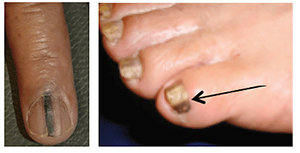
Not every dark streak is a melanoma, but it’s always good to have a
dermatologist examine one. Caught early and treated, that may be the
only treatment you need.
2. Medical name: Onycholysis
Nail lifting up
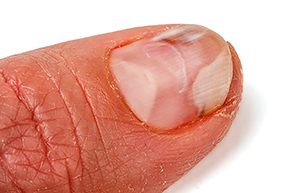
If a nail starts to lift up so that it’s no longer
completely attached, you’ll likely see white discoloration, as shown
here. When a nail lifts up, the cause is often:
A fungal infectionPsoriasisInjury from an aggressive manicureInjury form cleaning under your nails with a sharp object
A dermatologist should examine any nail that’s lifting up. You may need treatment to clear an infection. A dermatologist can also give you some tips that may help the new nail grow out normally.
3. Medical name: Paronychia

If you have redness and swelling around a nail, you may
have an infection. When diagnosed early, you can often treat an
infection with soaks and antibiotics. If an open sore forms, you’ll need
more extensive treatment.
4. Medical name: Paronychia
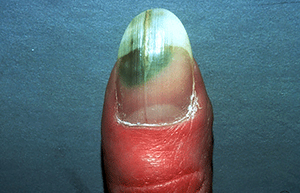
When bacteria cause a nail infection, the nail can turn greenish black as shown here.
5. Medical name: Pitting
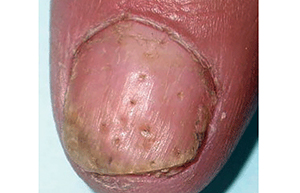
If you have dents in your nails that look like they
were made by an icepick, this could be a sign that you have a disease
that affects your entire body.
PsoriasisAtopic dermatitisAlopecia areata- Seeing a board-certified dermatologist for a diagnosis is important. Dermatologists are the specialists who diagnose and treat these diseases. Treatment can help you feel more comfortable and prevent the disease from worsening.
6. Medical name: Yellow nail syndrome
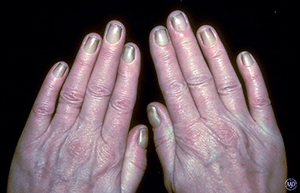
Wearing red nail polish without a base coat or smoking
can turn your nails yellow. If your nails turn yellow, thicken, and seem
to stop growing, it could be a sign of something going on inside your
body.
7. Medical name: Beau lines
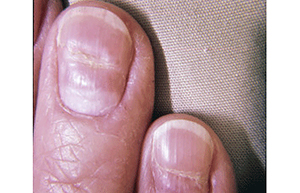
Lines that run the length of a nail are common and
usually nothing to worry about. If you see deep grooves that run the
width of your nail like the ones shown in this picture, it means that
something slowed (or stopped) your nails from growing for a while.
8. Medical name: Onychogryphosis
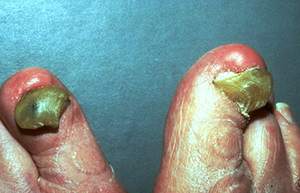
This happens when the nails thicken and overgrow. Some people get Ram’s horns because the condition runs in the family.
9. Medical name: Koilonychia

If you have thin fingernails that dip down in the
middle and look like spoons, you may not be getting enough iron. People
develop an iron deficiency for many reasons, including:
Lack of proper nutritionA health problem with their stomach or intestinesSensitivity to gluten (celiac disease)High altitude
Getting a proper diagnosis and treatment can help you feel better.
10. Medical name: Onychotillomania
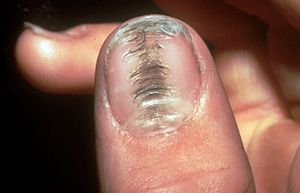
If you have grooves and ridges in the center of your
thumb that look like the ones shown in this picture, you may have
developed a habit of picking at (or pushing back) the cuticles on your
thumbnails. Many people are unaware that they do this.
11. Medical name: Clubbing
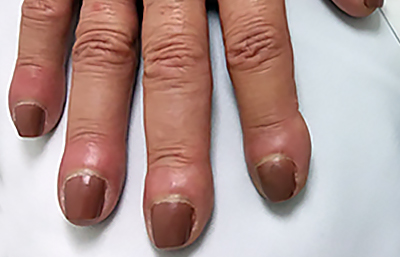
The curving can begin so gradually that many people are
unaware it's happening. As the nails continue to curve downward,
fingertips often swell and the nails start to feel spongy when pressed
on.
LungsHeartLiverStomach or intestine
12. Color change
specific disease, as the following table shows.
| Color | Disease or other health problem |
|---|---|
| Blue nails | Not enough oxygen in your bloodstream |
| White nails | Liver disease, diabetes |
| Pale nails | Anemia |
| Half pink, half white nails | Kidney disease |
| Yellow nails | Lung disease, nail infection |
| Dusky red half-moons | Could be lupus, heart disease, alopecia areata, arthritis, dermatomyositis |
| Blue half-moons | Could be sign of poisoning |
Seeing a change to your nails or the half-moons doesn’t always mean that you have a disease. Still, it’s important to see a board-certified dermatologist if you notice any changes. Board-certified dermatologists specialize in diagnosing and treating the skin, hair, and nails. They have the expertise to tell you whether the change is harmless or requires medical testing. | ||||||||||||
This is only for your information, kindly take the advice of your doctor for medicines, exercises and so on. https://gscrochetdesigns.blogspot.com. one can see my crochet creations https://gseasyrecipes.blogspot.com. feel free to view for easy, simple and healthy recipes https://kneereplacement-stickclub.blogspot.com. for info on knee replacement https://cancersupportindia.blogspot.com for infor on cancer and health related topics https://GSiyers home remedies.blogspot.com is the latest addition to my blogs. I'm going to add posts there, do give me your valuable feed back on my blogs. Thanks a lot, take care, be healthy and be happy. | ||||||||||||
Labels: color changes= diseases, curved, deep groves, greenish black colour, nail issues- dark streak, nail lifting up, pitted nails, Ram's horn nails, redness & swelling around, thin spoon-shaped, washboard, yellow

0 Comments:
Post a Comment
<< Home